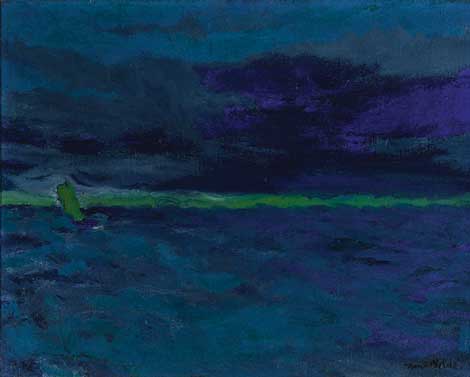The inclusion of Emil Nolde in the excellent exhibition, “Expressionism in Germany and France: From Van Gogh to Kandinsky” at the Los Angeles County Museum of Art, is a brilliant decision, though Nolde was not known for joining groups for very long. Many of his paintings are lost or destroyed, but LACMA has found two I have never seen and they are extraordinary.
One is a seascape called Blue Sea (1914)—dark, moody and ominous in its lack of color. The other portrays a harbor, Ship in Dock (1910)—oily water glistens with reflections and a strange lurking quality. We all know Nolde for his brightly colored faces and intense flowers, but these two pieces call up a language I have rarely seen except in movies.
Nolde was into color like most of the artists who belonged to Die Brücke (The Bridge), a group of German expressionist artists formed in Dresden in 1905. He believed that color was directly connected to our emotions; or rather he knew it could command his emotions and felt bad for people without this awareness. Pink was sheer happiness to him, but he lived in a purer time for color. (Now pink has been polluted by commercial cuteness that makes you want to vomit, a color that makes you think of rubber in various unattractive forms, a color that is unreal and has deviant commercial agendas.) So looking at Nolde’s flowers is difficult unless you realize that his days were literally darker and uncorrupted by commercials.
His use of yellow, however, is genius. It borders on insane in the paintings of masks but it also gives life to the women of the night. I have trouble with yellow—something about the primary-colored building blocks in nursery school, only to be followed by the yellow happy face later on in life. But Nolde’s yellow on the face of a strange lady makes you trust her instead of your surroundings. He does it all the time, and every time I fall for it; I want her to be real and suddenly she is real and I am not. It is addictive, just like his green. It’s always the same green, and soon you recognize it and never want it to go away—like heroin, you’re sure you will die without it. Nolde believed that color was as powerful as the music that can make you cry. But it’s not the color alone. It’s not another minimal canvas of boring rectangular red. It’s the way the color touches her cheekbone. It’s the yellow flare across her forehead that gives her life. It gives her the power to fascinate you forever.
I cannot speak of Nolde’s two paintings of water in this exhibition. It would be like trying to describe music with words: impossible. These paintings are to be seen, not described. They are sacred because like the chalice of medieval times, these paintings hold a mystery, something unearthly.
“Expressionism in Germany and France: From Van Gogh to Kandinsky” at LACMA; ends Sept. 14, 2014; lacma.org


